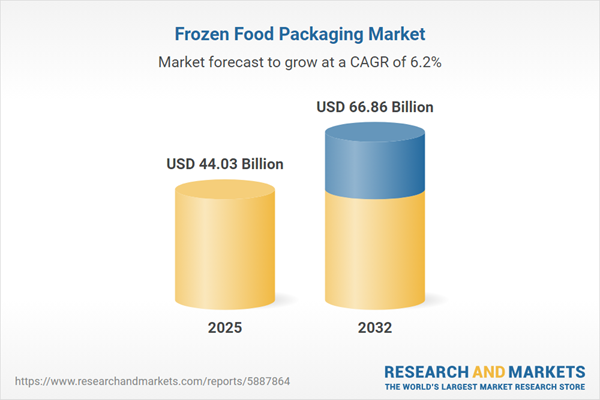Speak directly to the analyst to clarify any post sales queries you may have.
Frozen food packaging is evolving rapidly to align with shifting consumer demands for convenience and sustainability. As companies seek to optimize product protection and reduce environmental impact, frozen food packaging has become central to both operational strategy and long-term business growth.
Market Snapshot: Frozen Food Packaging Market Growth
The Frozen Food Packaging Market grew from USD 41.48 billion in 2024 to USD 44.03 billion in 2025. It is projected to expand at a compound annual growth rate (CAGR) of 6.15%, reaching USD 66.86 billion by 2032. This strong performance is supported by ongoing advances in material science, changing consumer habits, and rigorous regulatory requirements shaping both regional and global supply chains.
Scope & Segmentation of the Frozen Food Packaging Market
This report offers a rigorous breakdown of the frozen food packaging value chain. Analyze segmentation across key criteria to inform investment and operational choices:
- Material Types: Glass; Metal (Aluminum, Steel); Paperboard (Coated Paperboard, Corrugated, Solid Bleached Board); Plastic (Polyethylene, Polyethylene Terephthalate, Polypropylene, Polyvinyl Chloride).
- Packaging Formats: Flexible (Bags, Film, Pouches); Rigid (Boxes, Containers, Cups, Trays); Semi Rigid (Cartons).
- Applications: Bakery & Confectionery; Meat & Seafood; Ready Meals; Vegetables & Fruits.
- End Uses: Foodservice; Retail.
- Technologies: Active Packaging (Moisture Regulators, Oxygen Scavengers); Intelligent Packaging (RFID Tags, Time Temperature Indicators); Modified Atmosphere Packaging; Vacuum Packaging.
- Geographic Coverage: Americas (United States, Canada, Mexico, Brazil, Argentina, Chile, Colombia, Peru); Europe, Middle East & Africa (United Kingdom, Germany, France, Russia, Italy, Spain, Netherlands, Sweden, Poland, Switzerland, United Arab Emirates, Saudi Arabia, Qatar, Turkey, Israel, South Africa, Nigeria, Egypt, Kenya); Asia-Pacific (China, India, Japan, Australia, South Korea, Indonesia, Thailand, Malaysia, Singapore, Taiwan).
- Industry Stakeholders: Comprehensive company analysis covers Amcor plc, Sealed Air Corporation, Berry Global, Inc., Huhtamaki Oyj, Pactiv Evergreen Inc., Winpak Ltd., Mondi plc, Sonoco Products Company, Constantia Flexibles Group GmbH, and Reynolds Consumer Products LLC.
Key Takeaways: Strategic Insights for Decision-Makers
- Sustainable material adoption is rising as brands respond to stricter regulations and heightened consumer expectations around environmental impact.
- Advancements in active and intelligent packaging support product freshness, traceability, and quality assurance for increasingly complex supply chains and fast-moving distribution networks.
- Flexible and semi-rigid formats are gaining popularity in both foodservice and retail channels to facilitate portion control, convenience, and efficient handling.
- Collaborative efforts between packaging designers, material suppliers, and brand owners are unlocking application-specific solutions, particularly in response to distinct regional needs.
- Segment proliferation allows for specialized packaging approaches within bakery, seafood, meals, and produce sectors, ensuring each application benefits from tailored mechanical and barrier properties.
Tariff Impact on Frozen Food Packaging Supply Chains
Upcoming U.S. tariff adjustments are set to affect sourcing and cost structures for packaging materials, including metals and petroleum-derived polymers. These changes are prompting stakeholders to reassess their supplier strategies, invest in alternative substrates, and enhance risk-mitigation plans through long-term contracts and regional production shifts.
Frozen Food Packaging Market: Methodology & Data Sources
The report utilizes a hybrid methodology, combining primary interviews with executives from packaging manufacturers, material suppliers, brand owners, and logistics partners alongside secondary sources such as industry journals, regulatory filings, and technical white papers. Data triangulation and scenario planning ensure analytical rigor for stakeholder decision-making.
Why This Report Matters for Frozen Food Packaging Strategic Planning
- Delivers a comprehensive market analysis designed to inform procurement, product development, and investment initiatives.
- Equips leaders with actionable insights on key technological innovations, sustainability trends, and regional market variations.
- Enables supply chain resilience and cost mitigation as competitive priorities intensify due to evolving regulatory and tariff environments.
Conclusion
The frozen food packaging market is experiencing dynamic transformation driven by sustainability, innovation, and regulatory evolutions. Stakeholders who leverage timely insights and integrate best practices will secure enduring growth and market leadership within this vital sector.
Additional Product Information:
- Purchase of this report includes 1 year online access with quarterly updates.
- This report can be updated on request. Please contact our Customer Experience team using the Ask a Question widget on our website.
Table of Contents
3. Executive Summary
4. Market Overview
7. Cumulative Impact of Artificial Intelligence 2025
Companies Mentioned
The companies profiled in this Frozen Food Packaging market report include:- Amcor plc
- Sealed Air Corporation
- Berry Global, Inc.
- Huhtamaki Oyj
- Pactiv Evergreen Inc.
- Winpak Ltd.
- Mondi plc
- Sonoco Products Company
- Constantia Flexibles Group GmbH
- Reynolds Consumer Products LLC
Table Information
| Report Attribute | Details |
|---|---|
| No. of Pages | 180 |
| Published | November 2025 |
| Forecast Period | 2025 - 2032 |
| Estimated Market Value ( USD | $ 44.03 Billion |
| Forecasted Market Value ( USD | $ 66.86 Billion |
| Compound Annual Growth Rate | 6.1% |
| Regions Covered | Global |
| No. of Companies Mentioned | 11 |









